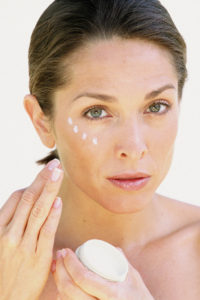
Peptides are compromised of a mere 20 amino acids. But the mathematical combinations between these 20 variables could theoretically be in the millions. But which combination(s) will be effective is the daunting question. Equally problematic is the issue of penetration into the skin. Since peptides are linked amino acids, the shorter the chain the better the penetration. Long chain peptides penetrate the skin very poorly.
One way that peptides may work is its effect on collagen, having a repairing influence. Skin is made up mostly of collagen which gives it support and thickness. Young people have lots of collagen and taut, smooth skin. As we age, collagen is destroyed but not replaced well. When collagen breaks down, it forms specific peptides. These peptides act as a signal to tell your skin it was damaged and to make new collagen. Applying the right peptide to your skin as we age is a way to make your skin think it needs more collagen. This is the theoretical approach to the use of palmitoyl pentapeptide (Matrixyl) for example. It can be found in many contemporary skin products and may have a positive effect on lessening the appearance of fine facial lines.
Peptides comprised of copper have good evidence of being helpful in promoting collagen production as well as an antioxidant effect. Copper has been documented to be helpful in chronic skin wounds for some time. It is logical, therefore, that if copper is attached to a peptide that it may be beneficial for skin regeneration by having an up regulation effect on fibroblasts, the cellular manufacturing plant of collagen.
Beyond collagen regeneration, peptides have been investigated as a potential relaxation agent as another approach to prevent skin wrinkling. Certain peptides may have an effect on the interaction between nerves and muscle. By impeding neurotransmission, the nerves that work the facial muscles may be weakened, similar to Botox. (although with not nearly the same potency) A neuropeptide acetyl hexapeptide-3 (argireline) is the most well known and is used in numerous high-priced topical products. A similar relaxing approach is that of pentapeptide-3 leuphasil (which blocks calcium uptake) and pentapeptide violox. (which blocks the receptors of acetlycholine) For now, these peptides seem like a theoretical addition to use with Botox but their real benefits as a stand alone treatment remain to be quantified.
The problem with peptides is not only their penetration issues but their activity levels. Without being able to pass through the stratum corneum, they will sit on the skin and be worthless. Much work has been done to attach peptides to penetrating agents. But having peptides that still have activity and bottling them into a jar or bottle is another hurdle. Because they are break-down products of proteins, they have to be stabilized or they will be essentially dead peptides which will be eventually washed away.
For now, collagen signaling peptides and the neuropeptides seem the most promising. But more clinical evidence will have to be forthcoming to determine their clinical benefits and whether they are worth the increased price of the products. In my Indianapolis plastic surgery practice, I find their current use is best used as an adjunctive treatment after Botox (neuropeptides) or after any form of skin resurfacing. (signaling peptides)
Dr. Barry Eppley
Indianapolis, Indiana


